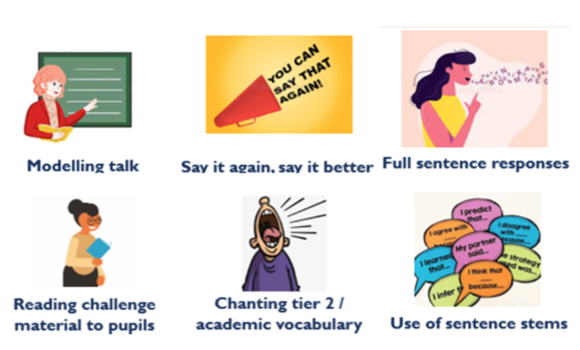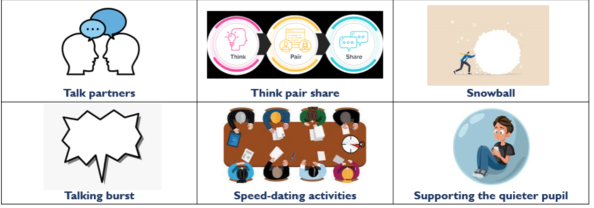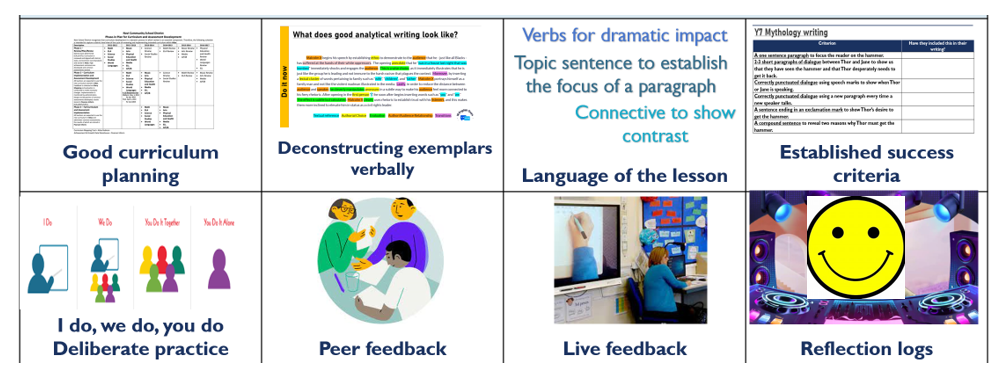‘Oracy is the ability to articulate ideas, develop understanding and engage with others through spoken language.’
There has been much debate about Oracy over the past few weeks with Labour’s announcement that it would form a central part of their educational priorities if they were to gain office. Many fear that it will become the next fad with schools quickly rushing to implement ‘oracy’. However, it isn’t simply an add-on or a fad, it is a critical component of good language teaching and should be carefully considered and planned for.
Oracy has been proven to have a measurable impact on both our pupils’ academic attainment and self-esteem. It functions as a great rehearsal for writing, allowing pupils to tease and deliberate over their ideas and interpretations before committing them to paper, whilst also providing the opportunity to practice and gain confidence in using an appropriate academic register. Not only this but in our post-covid world, oracy fosters greater connection, especially when opportunities to work with a variety of people are provided, which in turn, helps to build our pupils’ confidence. Most importantly, however, oracy plays a vital role in supporting our pupils to find, develop and empower their voices so that they can go out into the world, function and play an active part within our democratic society.
Voice 21, a leading organization and champion of oracy, offer five benchmarks for oracy teaching:
- High expectations are set for oracy in the classroom
- Every voice is valued
- Oracy is taught explicitly
- Oracy is harnessed to elevate learning
- Progress in oracy is appraised.
As an international teacher, working in an EAL classroom, developing pupils’ confidence and competence with oracy has been a core focus of mine for the past couple of years. This blog will outline some of my thinking and some of the work I have been developing. As always, though, it is fair to say I am an unfinished product with more to think about and more to do but isn’t that just the world of education?
Benchmark 1: High expectations are set for oracy in the classroom.
Benchmark 3: Oracy is taught explicitly.

I think Benchmarks 1 and 3 are fairly easy to begin to embed with actions that can be implemented from tomorrow and become staples of any lesson.
- Modelling talk – we have to model to pupils the talk we wish to see in them. Linked to this is the ‘say it again, say it better’ and our challenging of pupils when they do not articulate their responses using a high standard of talk. I insist on full sentence responses because when they can articulate full sentences, they can write full sentences.
- Tagged into this is modelling our reading. Research has proven that simply reading challenging material to pupils can help improve their literacy levels significantly.
- Part of my instructional routine when teaching tier 2 vocabulary is the chanting back of this vocabulary using the ‘I say, we say’ method. In modelling new vocabulary, we are sharing the correct pronunciation and articulation of words, which can then be mimicked by them so they assimilate them in the correct way. David Didau, in his new book, ‘Bringing the English Curriculum to life’ also talks about Echo reading, which works in a similar vein.
- Finally, I have a set of sentence stems on my wall to support oracy development. Phrases such as ‘In my opinion…’, ‘X said…which I agree / disagree with because..’/ ‘Similarly, I think…’ / ‘To build on what X said…’ These sentence stems can be drawn upon at any point by the pupils, but also by myself when demonstrating talk in the classroom and negotiating discussion.
Benchmark 2: Every voice is valued

I think this IS the essential focus of KS3: giving every pupil a space to develop their voice and supporting them to build their confidence with this and should be our core focus in Year 7 especially.
- I use talk partners throughout the year when I construct my seating plan. However, I change the seating plan on a termly basis to enable pupils to have the opportunity to work with many of their peers across the year. Posing a question and asking pupils to discuss with their talk partner is an easy win to share ideas privately before perhaps contributing to a wider discussion. I am currently reading David Didau’s new book ‘Bringing the English Curriculum to Life’ in which he suggests identifying one person in the pair as blue and one as red and giving them different ideas or perspectives to work with which I like and could build in too.
- Think pair share is well known but both Dylan Wiliam and Kate Jones remind us of the space for thinking first as being vitally important. So we pose a question, we let that question ruminate with our pupils for a good minute or two before discussing in pairs and then sharing within the wider context of the class.
- Similar to this method, is the snowball where you pose a question and an individual thinks about their response before discussing their response in a pair before discussing their response in a group of four before feeding back to the class. The key to all three methods above is in giving those more hesitant and nervous pupils the confidence to have an idea and check it out a number of times before being asked to share with a wider audience.
- Talking bursts are a lovely way to capture a burst of talking at any given point within a lesson. You might have been teaching a particular topic – say a poem and pupils may have completed a range of activities linked to the poem. You then find a moment of time in the lesson to ask pupils to put down their pens and discuss with their partner everything they have learnt about that said poem.
- I love speed dating activities and mostly do this with holiday reading in which I ask pupils to share their holiday read. Pupils sit opposite each other in two rows and have 30 seconds to a minute to share their book. Then they are asked to move one space along before repeating the task. And then they are asked to move one space along again after another 30 seconds and repeat. What this enables for is the rehearsal and improvement of talk across a period of time, before perhaps feeding back to the class.
What we need to remember, and I say this as an introvert myself, is that there will be some pupils who are secure in their learning but really are quite shy or reluctant to share their ideas with a wider group of people. These activities are all about creating a safe, secure environment where ideas and opinions can be tested and shared in a smaller space to build confidence over time. When these pupils are ready to commit to a wider audience, they will. There is danger in forcing them to commit too early and we need to be mindful of this.
Benchmark 4: Oracy is harnessed to elevate learning
Lev Vygotsky (1978) argued that
- children develop their understanding of the world and many of their cognitive abilities, through interaction with the people around them.
- children are born into an environment populated by people who they see and hear making sense of the world.
- language functions as both a cultural tool (whereby children can learn what others know and think) and a psychological tool (whereby children become able to use it to organise their own thinking).
- children can use their interactions with other people to develop their own thinking skills by ‘internalising’ the ways they hear and see others making sense of experience.
Three of these general kinds of thinking skills have been given particular attention by developmental psychologists in recent years: reasoning, self-regulation, metacognition
- Reasoning is essentially the ability to use the available evidence to assess competing explanations and to draw conclusions which can be justified on the basis of that evidence.
- Self-regulation means the ability to monitor one’s own processes to achieve the goals being pursued.
- Metacognition means the ability to reflect upon one’s own thinking processes, so as to review and evaluate plans and strategies which have been used and decisions which have been made.
So the question is how can we utilise talk to support these three thinking skills?

For me, it begins with our curriculum planning and our instructional sequence of teaching through which oracy is continually embedded.
- Deconstructing exemplars verbally – when we think about the unit we want to teach, we have an end product in mind. Deconstructing an exemplar end product helps us to articulate the components of what a good one looks like. Our ultimate goal then is that the pupils themselves can talk about what a good one looks like.
- The language surrounding these components areas of a good one should be embedded through all of our lessons so that they become the academic norm – they should become the language of the lesson. We know that the more exposure our pupils have to particular words, the more likely they are to embed them same with units of knowledge.
- Once we have looked at what a good one looks like, and taught the components of such, then we will have established our core success criteria. Having pupils articulate this in their own words further embeds their understanding of the key criterion. I usually do this in pairs using the key question: what does this actually mean to get them to unpick the core ideas behind the criteria.
- Once an understanding is complete, we can practise – using I do, we do, you do. Oracy plays an integral role here – as we are modelling, we are talking through the decisions we make and the reasons for those decisions, or the impact we want them to have. ‘We do’ is so vital in terms of pairs working together, utilizing each other to go through the process of writing against the exemplars and the success criteria. The articulating of what is needed also helps to embed the learning at this stage before a more silent you do is completed.
- Peer feedback is a brilliant tool for feedback. I have pairs, swap their work, read the piece they have inherited in silence before offering feedback. Pupils use the success criterion to articulate where they feel their peer has met certain criteria or not. In justifying this, pupils are further unpicking the language of the subject by evaluating the work and offering suggestions on how this can be improved.
- Similarly, live feedback works in the same way – taking a piece of work and looking at it against the success criteria but in front of a larger group, who can also feed into the evaluation of the piece. The number of pupils who adjust their work as you do this is always a fascinating thing to behold.
- Finally, and one of my favourite things that I have started to do in recent years is a reflection log, whereby pupils reflect upon their learning within a unit and how they went about creating their final piece – hopefully drawing upon all of the systems put in place. Pupils use a video platform to do this so the task is privately undertaken and I listen to this to review what they feel has been learnt.
As you can see, our instructional sequences of learning have oracy at the heart of them, providing multiple opportunities for teacher modelling of talk, group talk, peer talk and individual reflection.
Finally, there are two key pieces of work I have been doing to support the development of oracy in my classroom.
- The Individual Oral
- The Harkness discussion
The Individual Oral
As part of the IB programme, pupils in year 12/13 have to complete an Individual Oral in which they talk about a fiction and non-fiction work linked to a particular global issue. It is fundamentally, an oral essay.
Why not try this with year 7, I thought? So this year, I worked with year 7 on completing an Individual Oral, in which they compared a poem and a photograph.
We went through the instructional sequence above – analysing poems and photographs before arriving at the one they would use for their oral. We embedded the appropriate subject terminology as part of the language of the lesson. We established our success criteria – criteria for an introduction, strong topic sentences, relevant evidence, zooming in on language, comparative language, an effective conclusion. We practiced our understanding of what analytical writing looked and sounded like. We used a structured guide sheet to organize our thoughts and completed a practice oral, which I guided them through and they practised in pairs so they could receive peer feedback. And then they prepared and completed their final piece – recording their efforts outside of the classroom using their own devices. I was blown away by their results – their confident approach to the task and their eloquent way in which they articulated their thoughts about the two texts. Now the idea was they would only have the structured sheet to help them and, of course, some of them went to town on the detail BUT, in round 1, the focus was on creating a space for them to be able to articulate their response to two texts and to have confidence to do so and that is exactly what they did – in fact, for a few key pupils, it was the most I had ever heard them say.

The Harkness Discussion
As part of the IGCSE programme, pupils have to study 10 non-fiction texts and 15 poems. To break the teaching of these up, I initially teach the texts in 3 clusters linked by theme through flipped learning, alternating between a non-fiction text and a poem. Once a week pupils are issued with a copy of the text and are instructed to watch a flipped learning video that takes them through the text in relation to a conceptual question. They then are arrive at the weekly lesson dedicated to these texts, ready to participate in a Harkness discussion.
Backer (2015) argues most completely that the Harkness Table method, is ‘a dialogical student-centred style that prioritizes group address of a question in common in an equal and various sequence of turns.’

Six pupils form an inner circle with one person acting as chair. The chair poses the already agreed questions, which are then discussed in turn. The questions range from overall understanding, to conceptual thinking, to analysis of methods and comparison to suit the nature of the IGCSE. Pupils draw upon the texts and their notes to sustain this discussion and use the oracy stems around the classroom to help them listen and respond to each other effectively.
What is so brilliant about this, is that the pupils come armed with their pre-reading, which they draw upon but having considered the text beforehand, they also bring their own interpretations and thoughts to the analysis of the text. This widens the class’s interpretation of the text and puts the onus for thinking and learning on them. It supports them to develop confidence in their own voice and response to a text, whilst also having an anchor to work from.
At first, many pupils were hesitant but feedback once this had become embedded and routine included
‘At first, I found the harkness approach quite intimidating, but over time it helped build my confidence in sharing my ideas.’
‘I deeply enjoyed the flipped learning approach as I found myself looking forward to it each week. It was always interesting to have open discussions with peers and to have new input and interpretations stemming from different viewpoints. It also allows for a more open final judgement of the texts we read which could be helpful in the exam if trying to demonstrate a new and unique perspective to these texts.’
I have blogged about this strategy in more detail here: https://engteacherabroad.com/2022/01/16/approaching-the-igcse-anthology-flipped-learning-the-harkness-model-instructional-coaching-and-poster-summary-boards/
Of course, these are not the only planned for oracy activities – I have also had presentations on Vietnamese myths, Dragon’s Den presentations, persuasive speeches etc etc throughout the year.
The last word…
The point being is that oracy isn’t something new, it isn’t a fad and it isn’t something to be feared – it is an integral part of our job. We have a responsibility to support our pupils to become confident orators whether that be little tweaks to our day to day practice or in really strategically creating space and opportunities for oracy to really harness learning.
As always I would love to hear your comments…
